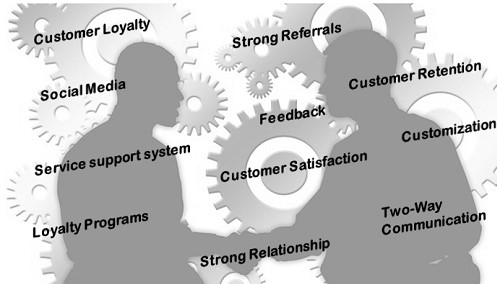In marketing, metrics are numbers that can be tracked to see how well a campaign is doing. These metrics can also help you figure out how well your marketing is getting people to do things that help your business. But using only one metric can give a wrong or misleading picture of the real world. This article talks about the marketing example of content, email, and social media metrics.
Marketing Metrics Example
From one industry to the next, metrics and the benchmarks that go with them carry different amounts of weight. Regardless of the industry, there are a few marketing signs that marketers pay extra attention to at different points in their customers’ journeys. The following is an example of marketing metrics:
#1. Cost per Lead (CPL)
CPL is the amount of money spent on a campaign or channel to get one new lead. You can use this indicator to figure out which of your marketing efforts is giving you the best return on your money. Pay attention to social media and other paid advertising channels, but keep your costs as low as possible to increase your acquisition rates.
#2. Rate of Leads Becoming Customers
Your marketing and sales teams need leads, but it’s also important to keep track of how many of those leads turn into paying customers. Check to see if your sales team could close deals faster if they had more leads, better leads, or better content.
#3. Cost per Acquisition (CPA)
The “cost per acquisition” is a way to figure out how much it costs to get one new customer. Your marketing efforts are on the right track if the cost per acquisition (CPA) is less than the revenue the customer generates over time. You can figure out the total CPA or the CPA for each channel to better allocate your resources.
#4. Customer Lifetime Value (CLV)
CLV is the amount of money a customer is likely to spend over the course of their relationship with your business. However, depending on what you sell and how you price it, this could mean getting customers to renew their licenses, upgrade their product plans, or buy more things from you. CLVs can also be estimated by looking at how similar customers have interacted with data in the past.
A marketer can use this measure to figure out how far their brand can reach on a certain channel compared to how many people can be reached overall. If something gets more attention, more people might buy it.
#6. The Number of Clicks
The click-through rate (CTR) is the number of clicks divided by the number of times an ad or link is shown. Because ads are “push” efforts, CTR is usually low. If your CTR is higher than 4%, you can be sure that your message is both relevant and convincing. But it’s important that you keep the promises you make to your audience for the rest of their trip. Some marketing solutions track CTRs in real-time, which lets programs be tweaked on the fly.
#7. Measures of Lead Generation
Marketing Cloud is a tool that uses AI to let marketers see all of their following leads from all of their marketing channels in one place. Automatically, these prospects are put in order based on how likely they are to become paying customers. Also, visitor-to-lead and lead-to-opportunity are common metrics for lead generation. They measure the number of website visitors who become leads and the number of leads who become opportunities.
#8. Return on Investment (ROI)
If you divide CLV by CPA, you can figure out the marketing return on investment. If your CPA is high but your CLV is low, you may need to change how you run your campaign.
#9. Getting Things Done
Make sure the people you’re trying to convince do what you want them to. It could mean giving your email address, signing up for a newsletter, or clicking a “call to action” button. Also, there will be many different ways to measure how successful a channel’s actions are. However, one action that can be measured is the number of people who sign up for a newsletter.
#10. Metrics That Are Mostly About the Company
For a business to be successful, it’s important to understand how marketers drive sales and growth. Marketers can also figure out how much their efforts have led to new or returning customers, business opportunities, income, and profits by using indicators that are unique to the company.
Content Marketing Metrics
Content marketing metrics can help you figure out how good your writing is. There are many things to keep an eye on, such as the number of new leads added to the sales funnel and how well your efforts to make people aware of your brand are working. The following is an example of marketing metrics for promoting content:
Since social media is quickly becoming one of the most popular ways for Internet users to talk to each other, it shouldn’t be a surprise that it’s important to keep an eye on what you share on social media.
#2. Page Views
When making new content, it can be helpful to know how long people spend on a certain page. So, if an article isn’t doing as well as you’d hoped, you can look at it to see what you could change to make it more popular.
#3. Backlinks
Now more than ever, it is important to have a strong network of backlinks. Even though the process of getting and verifying backlinks has changed, having strong backlinks will still help your SEO. However, you should look into the kinds of sites that link to you to find out how to improve the quality of your content and make it more likely to be linked to in the future.
Email Marketing Metrics
Email is still one of the best ways to reach your target audience and keep their attention. You can tell how well your email marketing metrics are doing by looking at the following things:
#1. Open Rates for Emails
“Open rate” refers to the number of people who actually opened your email out of the total number of people you sent it to. Also, to get the high open rate you want, you need to write an interesting subject line.
#2. The Bounce Rate for Emails
A non-delivery rate shows how many people have messages from you in their inboxes. However, to improve your subscriber lists, you should keep an eye on your hard bounces, which are usually caused by fake or broken email addresses, and your soft bounces (caused by transitory troubles).
#3. The Click-Through Rate for Emails
The CTR can be used to measure how well the content, design, calls to action, etc. of your email work. This is also one of the email marketing metrics.
#4. Unsubscribe Rate
When subscribers leave, it can be upsetting, but you should try to look on the bright side. People who aren’t interested in your brand will leave, leaving only those who are. Also, this could help you figure out important things about the people you want to reach.
#5. New Sign-Ups
By looking at subscription rates and patterns, marketers can figure out what makes people more interested in their brand. So, this indicator could help you figure out how to promote your email content.
#6. Subscribers Who Don’t Care
Like a social media account with no likes or comments, an email list with a lot of inactive subscribers is useless. In fact, these followers might make you think that your efforts to get people interested in your brand are working when they are not. If the list of subscribers is to stay healthy, inactive audiences need to be taken off of it regularly. However, automatic unsubscribing lets you send a message to inactive subscribers and remove them from your list after a certain amount of time.
Social media makes it much easier to connect with customers and build stronger bonds with them. But it doesn’t matter how many followers you have if they don’t interact with your brand’s posts. The number of shares, re-shares, likes, comments, pins, etc. can give you an idea of how engaged and happy your audience is.
A good indicator of how much consumers view a brand is participation on social media platforms. However, there are a number of KPIs that can be used to measure how well social media marketing is working for a business. The following example of social media marketing metrics is as follows:
#1. Engagement Metrics
A user is considered to be active if they like, comment on, follow, share, reshare, tag, etc. on content.
#2. Reach
The number of times your material is shown gives it more exposure. This is also one of the marketing metrics for social media.
#3. Impressions
The number of people who saw your work and how many times it was seen.
#4. Increase in Both New and Existing Followers
A good sign of success is how quickly your fan base grows over time.
#5. Traffic
The number of people who visit your site as a result of your social media efforts.
#6. Advertising Terminology
Finding mentions of your business may be all it takes to find out how much attention it is getting in different places. When you talk about other businesses, you give your own logo even more chances to stand out.
#7. Overall Revenue/Sales
Several monetizable platforms make it clear how much money advertisers and content providers can make on their sites. This can also help you figure out how your social media efforts translate into sales and cash.
Why Is It So Important to Keep an Eye on Key Marketing Metrics?
Marketing metrics can be used to measure how well a campaign did and to improve future efforts. They show how marketing efforts fit into the big picture of the company’s goals and help optimize decisions.
This kind of information is very helpful for a marketing team because it shows whether or not their efforts have paid off in terms of, say, bringing in new customers, keeping existing customers interested, making sales, and generating leads. If a marketing campaign isn’t doing as well as hoped, these digital metrics can let you know early on, so you can make quick, well-informed decisions about how to fix it.
Lastly, marketers use marketing data a lot to show how their work in this area has helped their business or organization. These kinds of insights are important because they can be used to plan annual budgets and figure out how many people to hire.
What Are the 5 Marketing Metrics?
The following are;
- The total number of changes that went well.
- Quantities of Exposure and Participation.
- The percentage of conversions through each channel.
- Per-acquisition or per-sale costs.
- Figuring out how much money one has made from investments.
What Are the 4 Types of Metrics?
Counting metrics, measuring metrics, histograms, and summaries are the four main categories of metrics.
What Are the Six Types of Marketing Metrics?
The following are;
- Cost of Getting a New Customer (CAC).
- How Much Marketing Invested in New Customers (M%-CAC)?
- Lifetime Value to Cost Per Acquisition ( LTV: CAC ).
- CAC needs to start getting paid back.
- Marketing efforts have an impact on the number of clients.
- Marketing could be responsible for a large number of buyers.
What Are the Different Types of Marketing Metrics?
The following are;
- Measures of a campaign’s effectiveness.
- ROAS (return on ad spend).
- The metrics of web searches.
- Quantitative measures of keyword popularity.
- A look at the rates of participation.
- Pageviews and leads.
- Rate of openness.
- CTR, or the rate of conversion.
What Are the Golden 4 Metrics?
The answer can be found in the four golden signals: high latency, high traffic, high error rates, and full resources. “Golden” in this case means the metrics and tags that we think are most important for a certain item.
Is KPI a Metric or a Matrix?
The Key Performance Indicator (KPI) Matrix on the dashboard makes it easy for users to get useful information about the growth and performance of the company. The term “key performance indicator” (KPI) refers to a number that is used to track and measure how well a business is doing at reaching its goals. Every business that wants to improve its performance needs to choose its key performance indicators with care.
You’ll need a set of metrics to track a key performance indicator if you want to know how well it’s doing, so choose them carefully. KPIs, or key performance indicators, are measurements, but not all measurements are KPIs.
Conclusion
It’s important to set KPIs for your marketing efforts that are unique to your company, industry, preferred channels, and types of campaigns. Metrics can help marketers decide what data to collect and how to look at it. Different marketing metrics will be needed for different channels, campaign goals, and campaign styles.
Related Articles
- KEY METRICS: Essential Metrics Every Business Should Have
- SUCCESS METRICS: Customer, Project, Business Metrics & All You Need
- The 3 most important elements of call tracking
- BUSINESS METRIC: Meaning, Examples, Dashboard, Reporting
- USER ENGAGEMENT: Meaning, Strategies & How-to-Increase Guide
- The Impact of Bitcoin’s $80K Rally on Australia’s Online Gambling Scene






